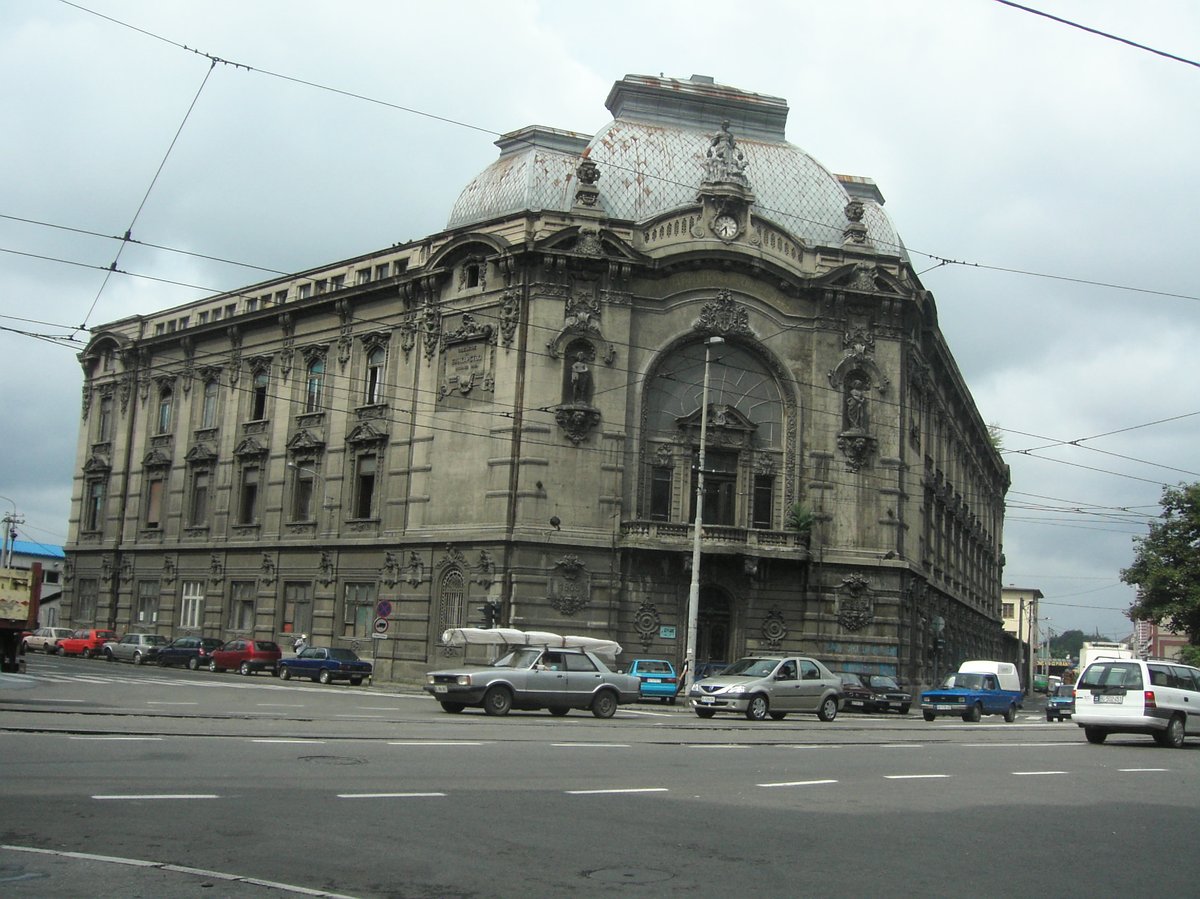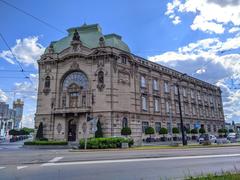
Belgrade Cooperative Visiting Hours, Tickets, and Historical Sites Guide
Date: 15/06/2025
Introduction
The Belgrade Cooperative, also known as “Beogradska zadruga” or the Geozavod building, is one of Belgrade’s most cherished historical and architectural landmarks. Established in 1882 to empower Serbia’s burgeoning middle class, the Cooperative played a vital role in the city’s transformation from a provincial town into a modern European capital. The building, constructed between 1905 and 1907 at a strategic riverside location in the Savamala district, stands as a symbol of Belgrade’s economic vigor and cultural ambition (Evendo; Wanderlog).
Architecturally, the Belgrade Cooperative is a prime example of the Serbian Secession style—a harmonious blend of Art Nouveau flourishes and traditional Serbian motifs. Its grand façade, ornate interiors, and innovative use of reinforced concrete reflect the optimism and technological progress of the early 20th century (Beotura; Koto.rs). The building has served a variety of roles over the decades, maintaining cultural relevance as a venue for exhibitions, public events, and creative gatherings (BINA).
Today, the Belgrade Cooperative is both a monument of exceptional importance and a gateway to the revitalized Savamala district—a lively hub of culture, art, and urban life. This guide provides a comprehensive overview of the site’s history, architecture, visitor information, travel tips, and nearby attractions, ensuring an enriching experience for every visitor.
Contents
- Brief History & Origins
- Architectural Significance
- Economic and Urban Impact
- Cultural and Social Role
- Visitor Information: Hours, Tickets, Tours & Accessibility
- Tips for Exploring Savamala and Nearby Attractions
- Visual and Media Recommendations
- FAQs
- Summary and Planning Tips
- Official Sources
Brief History & Origins
Founded in 1882, the Belgrade Cooperative was established to provide loans and financial services to Serbian merchants, craftsmen, and entrepreneurs. The Cooperative’s headquarters—the Geozavod building—was constructed between 1905 and 1907 at the intersection of Karađorđeva and Travnička streets. This location, close to the Sava River, was chosen to symbolize the city’s commercial vitality and connection to key trade routes (Evendo; Wanderlog).
Architectural Significance
Renowned architects Andra Stevanović and Nikola Nestorović designed the building in the Serbian Secession style, merging Art Nouveau elements with traditional Balkan motifs. The exterior is adorned with sculptural details, such as a grand entrance crowned by Mercury, the Roman god of commerce, and allegorical figures representing banking and insurance (Beotura; Koto.rs). The façade features elaborate stucco, artificial stone, and granite, while the interior boasts marble staircases, painted vaults, stained glass, and original chandeliers (Wikipedia).
Technically advanced for its time, the building was among the first in Belgrade to use reinforced concrete, ensuring stability near the Sava River (Koto.rs). Covering approximately 5,000 square meters, its spaces were designed for both business and public functions.
Economic and Urban Impact
The Belgrade Cooperative played a pivotal role in the modernization of Belgrade’s economy by providing financial services that empowered the city’s middle class. Its headquarters marked the beginning of modern urban reconstruction along the Sava embankment and inspired subsequent architectural developments (Wikipedia). Over the 20th century, the building adapted to changing political and economic landscapes, serving as a financial institution, administrative center, and cultural venue (BINA).
Cultural and Social Role
Throughout its history, the Belgrade Cooperative has been a hub for civic, business, and cultural events. The grand halls have hosted conferences, exhibitions, and public gatherings. In recent years, the building has undergone a cultural renaissance, becoming a regular venue for art exhibitions, concerts, and festivals. Its restoration is widely praised as a model of heritage preservation, balancing historical authenticity with modern functionality (BINA).
Savamala, the surrounding neighborhood, has evolved from a commercial center into a vibrant cultural district, filled with galleries, creative spaces, and trendy cafes (Destination Abroad). The Cooperative stands as both a historical anchor and a symbol of contemporary urban renewal.
Visitor Information: Hours, Tickets, Tours & Accessibility
Location: 2 Karađorđeva Street, Savamala district, central Belgrade (Meet Bosnia)
Visiting Hours:
- Exterior Viewing: Open 24/7 in a public space.
- Interior Access: Generally available during special events, exhibitions, or by guided tour. Common hours are Tuesday–Sunday, 10:00 AM to 6:00 PM. Closed Mondays and public holidays. Hours may vary; check with the venue or tourist information before your visit.
Tickets:
- Exterior: Free to view at all times.
- Interior/Guided Tours: Tickets cost 500–1000 RSD (4–8 EUR) depending on the provider; advance booking is recommended. Some events or exhibitions may be free, while others charge a nominal fee.
Guided Tours:
- Offered in Serbian and English, often daily at select times (e.g., 11:00 AM and 3:00 PM). Advance booking is advisable, especially during festivals or peak tourist seasons.
Accessibility:
- The building is wheelchair accessible, with ramps and elevators for public areas. Assistance for visitors with disabilities can be arranged on request.
Photography:
- Allowed in most public areas; flash and tripods are generally discouraged, especially during events.
Getting There:
- Savamala is easily accessible by tram (lines 7, 14) and bus. The main railway and bus stations are within a 10-minute walk. The nearest stop is “Savamala.”
Tips for Exploring Savamala and Nearby Attractions
While visiting the Belgrade Cooperative, consider exploring these nearby highlights:
- Sava River Promenade: Scenic riverside walkway.
- Kalemegdan Fortress: Historic site with panoramic city views.
- Knez Mihailova Street: Main pedestrian avenue rich in cafes, shops, and street performances.
- KC Grad: Cultural center and gallery with exhibitions and concerts.
- Beton Hala: Trendy riverside complex with restaurants and bars.
- Zeleni Venac Market: Historic open-air market (Never Ending Footsteps).
Dining: Savamala is renowned for its vibrant culinary and nightlife scene, with many cafes and eateries within walking distance.
Travel Tips:
- Wear comfortable shoes to explore the district.
- Visit in spring or autumn for pleasant weather and fewer crowds.
- English is widely spoken; signage is often bilingual.
- Carry some cash for markets, though most venues accept cards.
Visual and Media Recommendations
Enhance your visit with high-quality images of the building’s façade, interior details, and surrounding district. Look for photos with descriptive alt tags like “Belgrade Cooperative building façade—Serbian Secession architecture” or “Grand marble staircase of Belgrade Cooperative.” Many official tourism sites and travel apps offer interactive maps and, where available, virtual tours of the site.
Frequently Asked Questions (FAQ)
Q: Is there an entrance fee?
A: Viewing the exterior is free. Guided tours or special events inside may require a ticket (typically 500–1000 RSD).
Q: What are the visiting hours?
A: The exterior is accessible at all times. Interior access is by event or tour, usually Tuesday–Sunday, 10:00 AM–6:00 PM.
Q: Are guided tours available?
A: Yes, offered in English and Serbian. Book in advance for guaranteed access.
Q: Is the building accessible to people with disabilities?
A: Yes, most public areas are wheelchair accessible.
Q: Can I take photos?
A: Yes, but avoid flash and tripods during events.
Q: What else should I see nearby?
A: Sava River Promenade, Kalemegdan Fortress, Knez Mihailova Street, KC Grad, and more.
Summary and Planning Tips
The Belgrade Cooperative is a remarkable testament to Belgrade’s architectural innovation, historical transformation, and cultural vibrancy. Its Serbian Secession style and richly adorned interiors captivate visitors, while its location anchors a district renowned for creativity and nightlife. With free general admission for the exterior, accessible guided tours, and an active cultural calendar, the building is an essential stop for anyone exploring Belgrade’s heritage (Wikipedia; Evendo; Beotura; Destination Abroad; Meet Bosnia; Audiala).
For the latest visitor information, event schedules, or to book a tour, check with the Belgrade Tourism Official Site, the Belgrade Cooperative Building Official Page, or download the Audiala Travel App.
Official Sources
- Evendo: Belgrade Cooperative - Geozavod
- Wanderlog: Geozavod Belgrade Cooperative
- BINA: Home
- Beotura: Belgrade Cooperative Building
- Koto.rs: Belgrade Cooperative
- Wikipedia: Belgrade Cooperative Bank
- Destination Abroad: Is Belgrade Worth Visiting?
- Meet Bosnia: What to See in Belgrade: Best Local Tips
- Never Ending Footsteps: Things to Do Belgrade Serbia
- Audiala: Travel App
For more travel tips, historical insights, and event updates, download the Audiala app and follow us on social media. Experience the best of Belgrade’s heritage and vibrant urban culture in one unforgettable visit.








































































